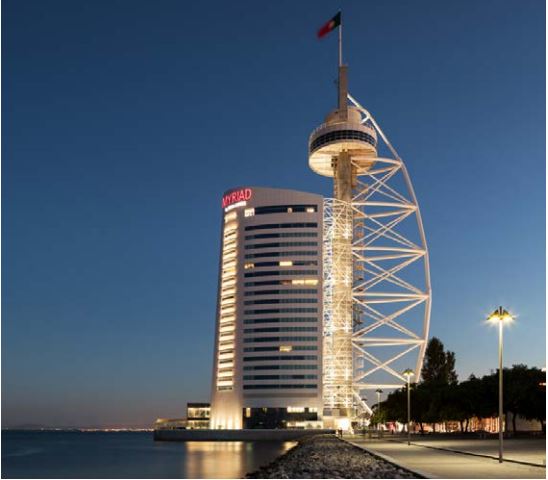
Myriad Hotel
These days, the decision to incorporate intelligent control systems is becoming less of an option and more of a necessity due to escalating energy costs coupled with measures adopted by the European Union in the interest of reducing building energy consumption. This situation, together with the highly competitive market and rapid technological progress, means that open control systems are gaining prominence due to their flexibility, effectiveness and ability to integrate with the rest of the building infrastructures.
September 2013 saw the opening of the Myriad Hotel by SANA Hotels – a 5-star complex in Parque das Nações, Lisbon, Portugal, beside the Vasco da Gama Tower, an impressive structure that debuted to the public at Expo 98 World’s Fair. Myriad Hotel has 186 rooms, divided into four different types by category: Deluxe, Premium, Suite and Presidential Suite.
From the inception of the project, the owner wanted an automation and control system to ensure optimum comfort for their guests while serving as an energy-saving tool to help reduce use and maintenance costs for the lighting and HVAC installations.The existing service infrastructure that needed to be integrated in the greater system consisted of hotel management software, interactive television services and a security system, all centralized from a SCADA system.
The Challenge
Meeting the owner’s needs required installation of approximately 1,200 LonWorks® devices to control more than 5,500 variables throughout the building. Its 23-floor height and 186 rooms spread meant it was necessary to set up an appropriately installed and segmented LON network using repeaters and routers to ensure proper communications between all control equipment and the server.
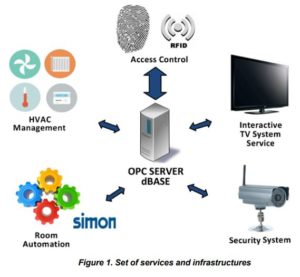
The Solution
The solution proposed to achieve the above objectives used the Simon MAXLON control system with LonWorks® technology. The main functions
applied as energy saving and efficiency measures cover individual HVAC parameter controls for each room. In addition, guests can manage the lighting, curtain and blind control using a card reader and display installed at each room’s entrance. This user interface allows for custom control of the environment and access to additional hotel services.

SCENARIO CONTROL
A card reader activation event is reflected by means of a welcome or farewell scenario in which interactive television services, main lighting circuits and indoor HVAC units are activated and the blinds and shades are positioned at an opening specific to each case. Other configured scenarios may be calls from button panels on the bed headboard to enable various lighting circuits to be switched on and off to adapt lighting levels at any time.
CLIMATE CONTROL
Indoor HVAC unit control is also subject to actual room occupation as well as automatic disconnection in cases of carelessness in closing windows or balconies. While the room is occupied, users can choose the operating mode, the setting value and fan speed at any time, with maximum and minimum thresholds controlled according to the season and the geographic orientation of each room. Rooms located on the north face of the building do not need the same cooling as those on the south face as there is not the same direct impact of the sun on that façade. This allows better control of demand management, prevention of unnecessary energy losses and increased equipment service life.
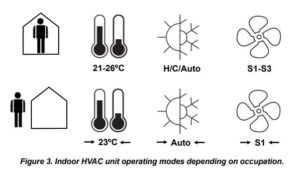
When a room is temporarily unoccupied the system goes into a low consumption state; the machine continues operating at a minimum fan speed and a temperature of 23 °C. To prevent the HVAC equipment remaining on once the guest has checked out, vacant rooms are sent a message to shut down the indoor HVAC units completely.
NETWORK ARCHITECTURE
Due to the building’s dimensions and the room layout, the network is segmented into various sub-networks. Each floor is made up of two LON TP/FT-10 (twisted pair) sub-networks linked together by a repeater to enable the communications bus lengths to be increased, as well as grow the number of devices supported by the network.
In turn, each floor network is connected to the others by means of LON routers through an IP 852 backbone. This enables all the building management installation variables to be controlled from the SCADA and managed by an OPC server which incorporates all the services offered by the hotel, as referred to above.
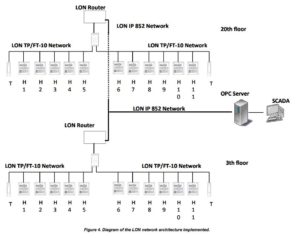
The Result
Keeping HVAC equipment running at minimum levels makes it possible to achieve clear improvements in the user’s acclimatization period after temporary absences. It does this by avoiding sharp rises or falls in temperature by making it possible to reach a comfortable temperature as soon as possible without the user feeling the need to switch on high-power HVAC equipment to reach it in the shortest possible time (Figure 5. Indoor temperature evolution in winter depending on whether or not there is a control mode in ECO operation).
These occupancy-based control strategies together with automatic shutdown of equipment exceeding maximum and minimum operating thresholds contribute significantly to achieving the objective of reducing costs deriving from operating HVAC services.
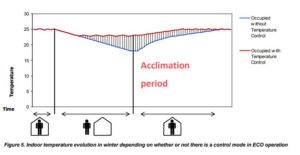
Similarly, integrated and intelligent lighting control based on occupancy and light level adaptation further reduces costs resulting from these services, while still maintaining high levels of comfort and safety.
The main advantage of working with open, interoperable control systems lies in enhanced benefits of an integrated system; it’s a case where the sum is greater than the parts. Given the great adaptability in operation, events that occur in coexisting control systems can now communicate and share data with the other network devices, as with orders sent automatically to building management system equipment from client management software.
For further information contact sat@simon.es or visit www.simon.es


